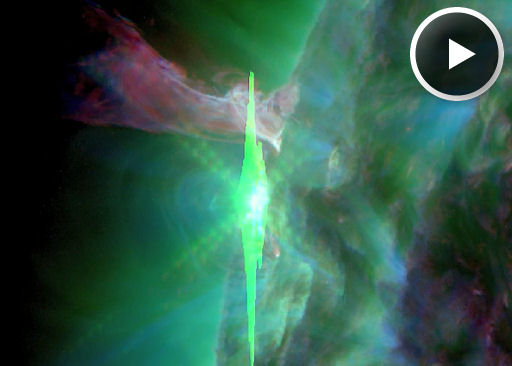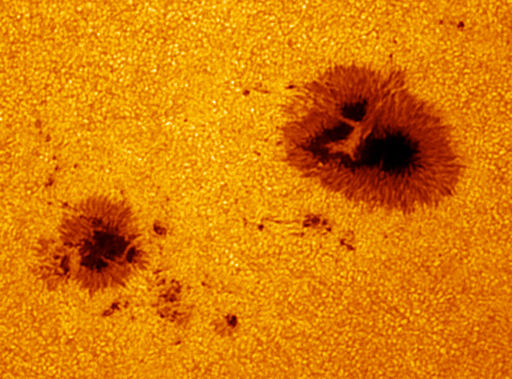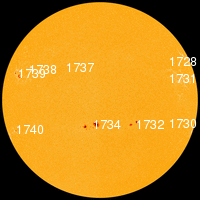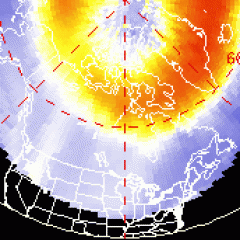~ Space Weather Update~ M Class Flares and M5 SOLAR TORNADO [1]
ETA AQUARID METEOR SHOWER: Earth is entering a stream of debris from Halley's Comet, source of the annual eta Aquarid meteor shower [2]. Forecasters expect the shower to peak on May 5th and 6th with as many as 55 meteors per hour in the southern hemisphere and half that number in the north. The best time to look is during the dark hours before local sunrise. [photo gallery [3]]
M5 SOLAR TORNADO: Sunspot group AR1739, just now emerging over the sun's northeastern limb, erupted on May 3rd, producing an M5-class [4] solar flare and a "solar tornado." Click on the image and watch the plasma twist:
The explosion also hurled a bright coronal mass ejection (CME) into space: movie [6]. Traveling almost 1300 km/s, the electrified cloud is expected to sweep past a couple of NASA spacecraft (EPOXI and Spitzer) on May 7th. No planets, however, were in the line of fire. Solar flare alerts: text [7], voice [8].
Realtime Space Weather Photo Gallery [9]
CHANCE OF FLARES: NOAA forecasters estimate a 45% chance of M-flares [4] today. The question is, where will the eruptions come from? There are at least three choices: Sunspots AR1731, AR1734, and AR1739 all have 'beta-gamma' magnetic fields that harbor energy for strong eruptions. The largest of the three, AR1734, is directly facing Earth:
Amateur astronomer Pepe Manteca took the picture yesterday from Barcelona, Spain. The large dark core on the right is more than 3 times wider than Earth--dimensions that made the spot an easy target for Manteca's backyard solar telescope. "It is a stunning sunspot!" he says.
It could be even more stunning if it flares. Stay tuned! Solar flare alerts: text [7], voice [8].

![]()
Solar wind
speed: 423.0 km/sec
density: 2.4 protons/cm3
explanation [11] | more data [12]
Updated: Today at 1807 UT
![]()
X-ray Solar Flares
6-hr max: M1 1756 UT May05
24-hr: M1 1756 UT May05
explanation [13] | more data [14]
Updated: Today at: 1800 UT
![]()
![]()
![]()
Daily Sun: 05 May 13
![]()
![]()
Three sunspots have beta-gamma magnetic fields that harbor energy for M-class [4] solar flares: AR1731, AR1734, and AR1739. Credit: SDO/HMI
![]()
![]()
![]()
Sunspot number: 156
What is the sunspot number? [16]
Updated 04 May 2013
Spotless Days
Current Stretch: 0 days
2013 total: 0 days (0%)
2012 total: 0 days (0%)
2011 total: 2 days (<1%)
2010 total: 51 days (14%)
2009 total: 260 days (71%)
Since 2004: 821 days
Typical Solar Min: 486 days
Update 04 May 2013
The Radio Sun
10.7 cm flux: 148 sfu
explanation [17] | more data [18]
Updated 04 May 2013
![]()
![]()
![]()
Current Auroral Oval:
![]()
Switch to: Europe, USA, New Zealand, Antarctica
Credit: NOAA/POES
![]()
![]()
![]()
Planetary K-index
Now: Kp= 2 quiet
24-hr max: Kp= 2 quiet
explanation [20] | more data [21]
![]()
Interplanetary Mag. Field
Btotal: 7.1 nT
Bz: 5.4 nT north
explanation [22] | more data [23]
Updated: Today at 1807 UT
![]()
![]()
![]()
Coronal Holes: 05 May 13
![]()
![]()
Solar wind flowing from this minor coronal hole should reach Earth on ~May 6-8. Credit: SDO/AIA.




